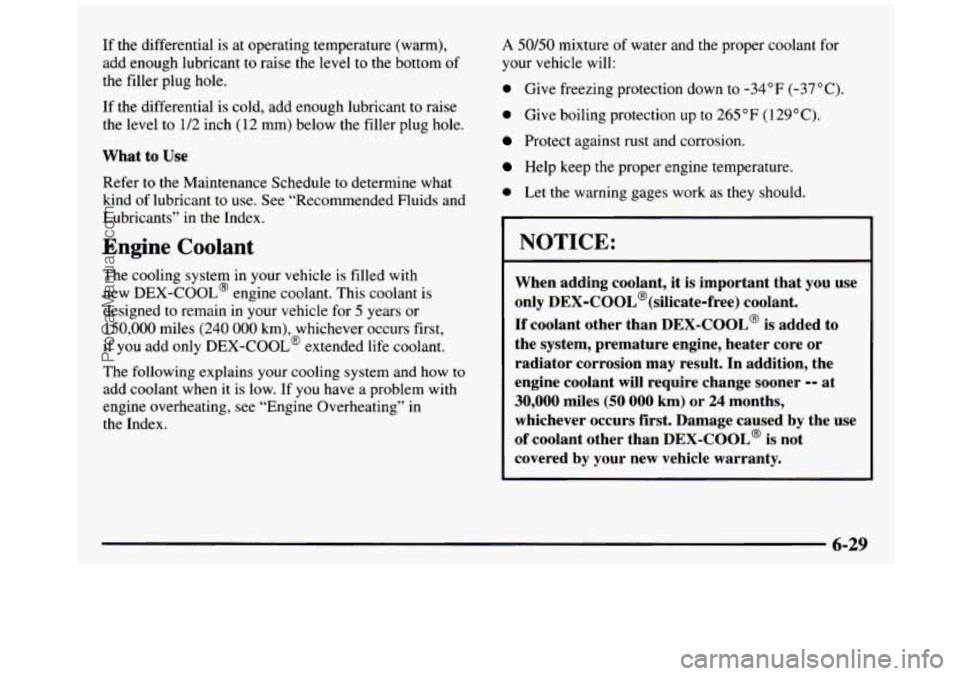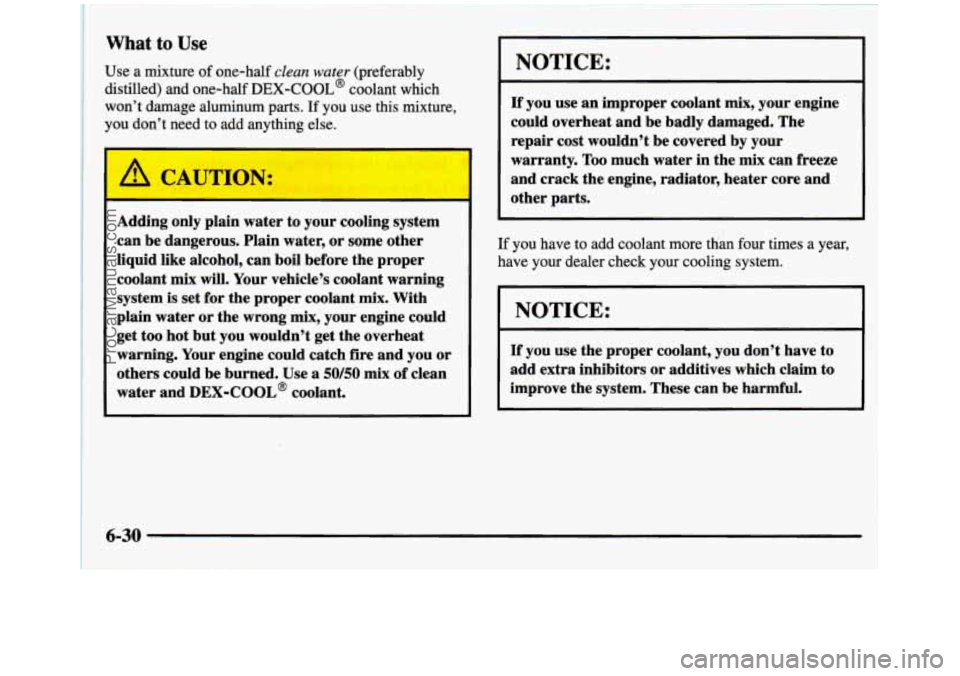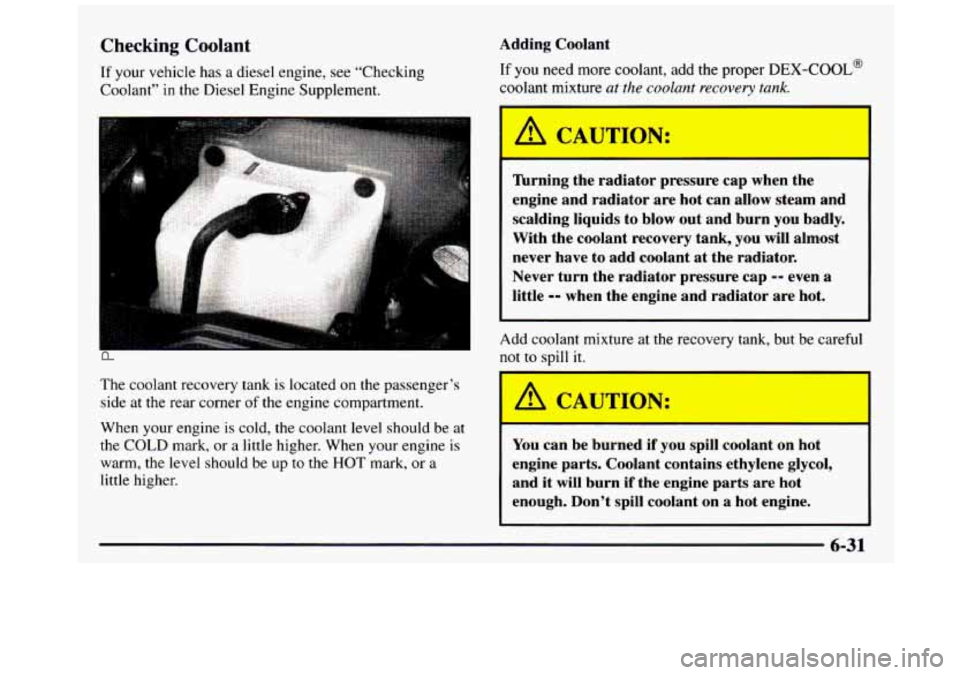Page 284 of 436
Checking Things Under the Hood
I A CAUTION:
If your vehicle has air conditioning, the auxiliary
engine fan under the hood can
start up and
injure you even when the engine
is not running.
Keep hands, clothing and tools away from any
underhood electric
fan.
t -4
Things that burn can get on hot engine parts and
start a fire. These include liquids like gasoline or
diesel fuel, oil, coolant, brake fluid, windshield
washer and other fluids, and plastic or rubber. You or others could be burned. Be careful
not to drop or spill things that will burn onto
a hot engine.
ProCarManuals.com
Page 287 of 436
A. Battery
B. Air Cleaner
C. Radiator Cap
D. Coolant Recovery Tank
E. Air Filter Restriction Indicator
F. Engine Oil Dipstick
G. Automatic Transmission Dipstick
H. Fan
I. Power Steering Fluid Reservoir
J. Engine Oil Fill
K. Brake Fluid Reservoir
L. Windshield Washer Fluid Reservoir
M. Fuse/Relay Center
6-11
ProCarManuals.com
Page 289 of 436
A. Battery
B. Coolant Recovery Tank
C. Air Cleaner
D. Radiator Cap
E. Air Filter Restriction Indicator
E Engine Oil Dipstick
G. Automatic Transmission Dipstick
H. Engine Oil Fill
I. Fan
J. Power Steering Fluid Reservoir
K. Brake Fluid Reservoir
L. Windshield Washer Fluid Reservoir
M. FuseRelay Center
6-13
ProCarManuals.com
Page 295 of 436
Air Cleaner (Gasoline Engines)
Your air cleaner is located between the battery and
coolant recovery tank. The
air cleaner assembly
has an indicator that lets
you know when the air filter
is dirty and needs to be
serviced. The indicator
is
located in the air intake
tube between the air cleaner
and the engine.
See “Owner Checks and Services” in the Index to
determine when to check the indicator.
If the area inside the clear section of the indicator is
green, no air filter service is required. When the area
inside the indicator is orange and
CHANGE AIR
FILTER appears, the filter should be replaced.
6-19
..
ProCarManuals.com
Page 305 of 436

If the differential is at operating temperature (warm),
add enough lubricant to raise the level to the bottom of
the filler plug hole.
If the differential is cold, add enough lubricant to raise
the level to 1/2 inch (12 mm) below the filler plug hole.
What to Use
Refer to the Maintenance Schedule to determine what
kind of lubricant to use. See “Recommended Fluids and
Lubricants” in the Index.
Engine Coolant
The cooling system in your vehicle is filled with
new DEX-COOL@ engine coolant. This coolant is
designed to remain in your vehicle for
5 years or
150,000 miles (240
000 km), whichever occurs first,
if
you add only DEX-COOL@ extended life coolant.
The following explains your cooling system and how to
add coolant when
it is low. If you have a problem with
engine overheating, see “Engine Overheating” in
the Index.
A 50/50 mixture of water and the proper coolant for
your vehicle will:
0 Give freezing protection down to -34°F (-37°C).
0 Give boiling protection up to 265 “F (1 29°C).
Protect against rust and corrosion.
Help keep the proper engine temperature.
0 Let the warning gages work as they should.
NOTICE:
When adding coolant, it is important that you use
only
DEX-COOL@(silicate-free) coolant.
If coolant other than DEX-COOL@ is added to
the system, premature engine, heater core or
radiator corrosion may result. In addition, the
engine coolant will require change sooner
-- at
30,000 miles (50 000 km) or 24 months,
whichever occurs first. Damage caused by the use
of coolant other than DEX-COOL@ is not
covered by your new vehicle warranty.
ProCarManuals.com
Page 306 of 436

What to Use
Use a mixture of one-half clean water (preferably
distilled) and one-half
DEX-COOL’ coolant which
won’t damage aluminum parts.
If you use this mixture,
you don’t need to add anything else.
A CAUTION:
Adding only plain water to your cooling system
can
be dangerous. Plain water, or some other
liquid like alcohol, can boil before the proper
coolant
mix will. Your vehicle’s coolant warning
system is set for the proper coolant
mix. With
plain water or the wrong
mix, your engine could
get too hot but you wouldn’t get the overheat
warning. Your engine could catch fire and you or
others could be burned. Use a
50/50 mix of clean
water and
DEX-COOL@ coolant.
NOTICE:
If you use an improper coolant mix, your engine
could overheat and be badly damaged. The
repair cost wouldn’t be covered
by your
warranty. Too much water in the mix can freeze
and crack the engine, radiator, heater core and
other parts.
If you have to add coolant more than four times a year,
have your dealer check your cooling system.
NOTICE:
If you use the proper coolant, you don’t have to
add extra inhibitors or additives which claim to
improve the system. These can be harmful.
6-30
ProCarManuals.com
Page 307 of 436

Checking Coolant
If your vehicle has a diesel engine, see “Checking
Coolant”
in the Diesel Engine Supplement. Adding Coolant
If you need more
coolant, add the proper DEX-COOL@
coolant mixture
at the coolant recovery tank.
The coolant recovery tank is located on the passenger’s
side at the rear corner
of the engine compartment.
When your engine is cold,
the coolant level should be at
the
COLD mark, or a little higher. When your engine is
warm, the level should be up to the HOT mark, or a
little higher.
A CAUTION:
Turning the radiator pressure cap when the
engine and radiator are hot can allow steam and
scalding liquids to blow out and burn you badly.
With the coolant recovery tank, you will almost
never have to add coolant at the radiator.
Never turn the radiator pressure cap
-- even a
little -- when the engine and radiator are hot.
Add coolant mixture at the recovery tank, but be careful
not to spill
it.
You can be burned if you spill coolant on hot
engine parts. Coolant contains ethylene glycol,
and it will burn if the engine parts are hot
enough. Don’t spill coolant on a hot engine.
6-31
~ .
ProCarManuals.com
Page 308 of 436
Radiator Pressure Cap
(Gasoline Engine)
The radiator pressure cap must be tightly installed with
the arrows
on the cap lined up with the overflow tube on
the radiator filler neck.
NOTICE:
Your radiator cap is a 15 psi (105 kPa)
pressure-type cap and must be tightly installed to
prevent coolant loss and possible engine damage
from overheating. Be sure the arrows on the cap line up with the overflow tube on the radiator
filler neck.
Thermostat
Engine coolant temperature is controlled by a thermostat
in the engine coolant system. The thermostat stops the
flow
of coolant through the radiator until the coolant
reaches a preset temperature.
When you replace your thermostat, an
AC@ thermostat
is recommended.
6-32
ProCarManuals.com